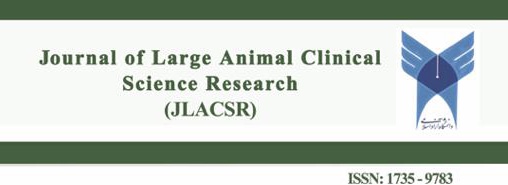Seroprevalance of Neospora caninum in Miyaneh sheep (Azarbayejan-e-Shargi province) by competitive ELISA and IFA methods
Subject Areas :
Journal of Veterinary Clinical and Laboratory Research(JLACSR)
Received: 2021-08-15
Accepted : 2021-08-15
Published : 2014-04-21
Keywords:
Sheep,
Elisa,
Neospora caninum,
Neosporosis,
IFA,
Abstract :
Neospora caninum is an animal protozoan that causes reproductive failure in sheep. The aim of current study is to determine seroprevalence of N. caninum in sheep of Miyaneh, Northwest Iran by two methods of competitive Enzyme linked immunosorbent assay (cELISA) and indirect immunofluorescence assay (IFA) in 2012. 317 sera samples were obtained from 9 villages and were tested. Seroprevalence of N. caninum was 4.1% (13 sera) by ELISA and the most of positive sera were in the inhibition range of 30- 40%. 8 (2.52%) sera were positive by IFA and the most observed positive titer in this test was 1:64. Regarding IFA as golden test, the sensitivity and specificity of ELISA were 61.5% and 100%, respectively and the positive and negative predictive values were 100% and 98.3%, respectively. The agreement between two tests were 98.4% and the Kappa coefficient was 0.755 (p<0.001). The results showed low seroprevalence and environmental exposure in sheep of this region to the parasite.
References:
· Bjerkas, I., Mohn, S. F., Presthus, J., (1984). Unidentified cyst-forming sporozoon causing encephalomyelitis and myositis in dogs. Zeitschrift für Parasitenkunde. (70): 271–274.
· Buxton, D., (1998). Protozoan infections (Toxoplasma gondii, Neospora caninum and Sarcocystis spp.) in sheep and goats: recent advances. Veterinary Research. (29): 289-310.
· Dubey, J. P., (2003). Review of Neospora caninum and neosporosis in animals. Korean Journal of Parasitology. (41): 1–16.
· Dubey, J. P., Buxton, D., Wouda, W., (2006). Pathogenesis of bovine Neosporosis. Journal of Comparative Pathology. (134): 267–289.
· Dubey, J. P., Carpenter, J. L., Speer, C. A., Topper, M. J., Uggla, A., (1988). Newly recognized fatal protozoan disease of dogs. Journal of the American Veterinary Medical Association. (192): 1269–1285.
· Dubey, J. P., Lindsay, D. S., (1990). Neospora caninum induced abortion in sheep. Journal of Veterinary Diagnostic Investigation. (3): 230-233.
· Dubey, J. P., Schares, G., (2006). Diagnosis of bovine Neosporosis. Veterinary Parasitology. (141): 1–34.
· Dubey, J. P., Schares, G., Ortega-Mora Clin, L. M., (2007). Epidemiology and Control of Neosporosis and Neospora caninum, Microbiological reviews. 20 (2): 323.
· Hassig, M., Sager, H., Reitt, K., Ziegler, D., Strabel, D., Gottstein, B., (2003). Neospora caninum in sheep: a herd case report, Veterinary Parasitology, (117): 213-220.
· Helmick, B., Otter, A., Mcgarry, J., Buxton, D., (2002). Serological investigation of aborted sheep and pigs for infection by Neospora caninum. Research in Veterinary Science. (73): 187.
· Howe, L., West, D. M., Collet, M. G., Tattersfield, G., Pattison, R. S., Pomory, W. E., Kenyon, P. R., Morris, S. T., Williamson, N. B., (2008). The role of Neospora caninum in three cases of unexplained abortions in the southern North Island of New Zealand. Small Ruminant Research. (75): 115-122.
· Kobayashi, Y., Yamada, M., Omata, Y., Koyama, T., Saito, A., Matsuda, T., Okuyama, K., Fujimoto, S., Furuoka, H., Matsui, T., (2001). Neospora caninum infection in an adult sheep and her twin fetuses. The Journal of Parasitology. (87): 436-437.
· Langoni, H., Junior, H. G., Guimaraes, F. F., Ullman, L. S., Gaio, F. C., Uehara, R. S., Rosa, E. P., Amorim, R. M., Da Silvia, R. C., (2011). Serological profile of Toxoplasma gondii and Neospora caninum infection in commercial sheep from Sao Paulo State, Brazil, Veterinary Parasitology. (177): 50-54
· Lobato, J., Silva, D. A. O., Mineo, T. W. P., Amaral, J. D. H. F., Segundo, G. R. S., Costa-Cruz, J. M., Ferreira, M. S., Borges, A. S., Mineo, J. R., (2006). Detection of immunoglobulin G antibodies to Neospora caninum in humans: high seropositivity rates in patients who are infected by human immunodeficiency virus or have neurological disorders. Clinical and Vaccine Immunology. (13): 84–89.
· Ortega-Mora, L. M., Ferna´ndez-Garcı´a, A., Go´mez-Bautista, M., (2006). Diagnosis of bovine Neosporosis: recent advances and perspectives. Acta Parasitologica. (51): 1–14.
· Pena, H. F. J., Soar, H., July, F., (2007). Isolation and molecular detection of Neospora caninum from naturally infected sheep from Brazil. Veterinary Parasitology. (147): 61-66
· Rossi, G. F., Cabral, D. D., Ribeiro, D. P., Pajuaba, A. C. A. M., Correa, R. R., Moreira, R. Q., Mineo, T. W. P., Mineo, J. R., Silvia, D. A. O., (2001). Evaluation of Toxoplasma gondii and Neospora Caninum infections in sheep from Uberlandia, Minas Gerais State, Brazil, by different serological methods, Veterinary Parasitology. (175): 252-259.
· Salaberry, S. R. S., Okuda, L. H., Nassar, A. F. C., Castro, J. R., Lima-Riberio, A. M. C., (2010).Prevalence of Neospora caninum antibodies in sheep flocks of Uberlandia county, MG, Rev. Bras. Veterinary Parasitology. (19): 148-151.
· Soares, H. S., Ahid, S. M. M., Bezerra, A. C. D. S., Pena, H. F. J., Dias, R. A., Gennari, S. M., (2009). Prevalence of anti-Toxoplasma gondii and anti- Neospora caninum antibodies in sheep from Mossoro, Rio Grande de Norte, Brazil, Veterinary Parasitology. (160): 211-214.
· Spilovska, S., Reiterova, K., Kovacova, D., Bobakova, M., Dubinsky, P., (2009). The first finding of Neospora caninum and occurrence of other abortificient a gents in sheep in Slovakia, Veterinary Parasitology. (164): 320-323.
· Tranas, J., Heinzen, R. A., Weiss, L. M., McAllister M. M., (1999). Serological evidence of human infection with the protozoan Neospora caninum. Clinical and Diagnostic Laboratory Immunology. (6): 765–767.
_||_

